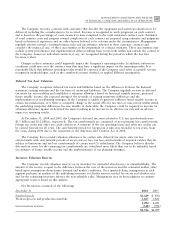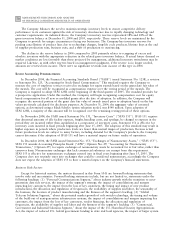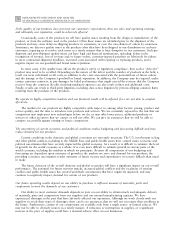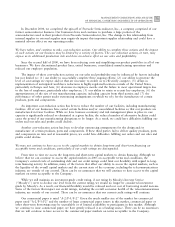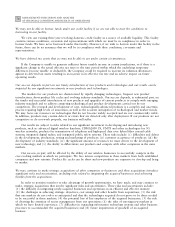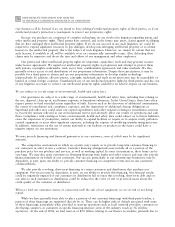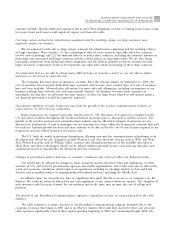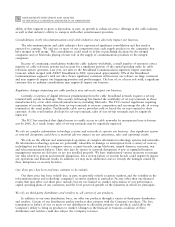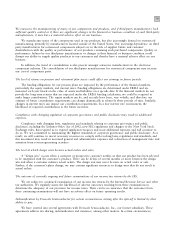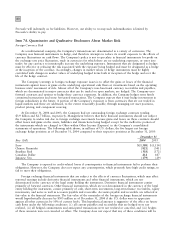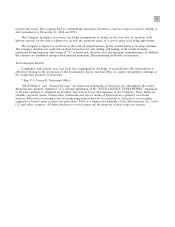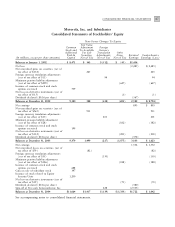Motorola 2004 Annual Report Download - page 85
Download and view the complete annual report
Please find page 85 of the 2004 Motorola annual report below. You can navigate through the pages in the report by either clicking on the pages listed below, or by using the keyword search tool below to find specific information within the annual report.
77
MANAGEMENT'S DISCUSSION AND ANALYSIS
OF FINANCIAL CONDITION AND RESULTS OF OPERATIONS
customer defaults. Should additional customers fail to meet their obligations on new or existing loans, losses could
be incurred and such losses could negatively impact our Ñnancial results.
Our large system contracts for infrastructure equipment and the resulting reliance on large customers may
negatively impact our business.
We are exposed to risks due to large system contracts for infrastructure equipment and the resulting reliance
on large customers. These include: (1) the technological risks of such contracts, especially when the contracts
involve new technology, and (2) the Ñnancial risks to us under these contracts, including the estimates inherent in
projecting costs associated with large contracts and the related impact on operating results. We are also facing
increasing competition from traditional system integrators and the defense industry as system contracts become
larger and more complicated. Political developments can impact the nature and timing of these large contracts.
It is important that we are able to obtain many diÅerent types of insurance, and if we are not able to obtain
insurance we are forced to retain the risk.
The Company has many types of insurance coverage. Since the terrorist attacks on September 11, 2001, the
cost of insurance has increased, deductibles have increased, and in some cases, certain types or levels of insurance
have not been available. Motorola also self-insures for some risks and obligations, including interruptions in our
business resulting from terrorist acts, and some natural disasters. As insurance becomes more expensive or
unavailable, we may have to self-insure for more matters. If there are large losses related to self-insured matters,
our Ñnancial performance would be negatively impacted.
Government regulation of radio frequencies may limit the growth of the wireless communications industry or
reduce barriers to entry for new competitors.
Radio frequencies are required to provide wireless services. The allocation of frequencies is regulated in the
U.S. and other countries throughout the world and limited spectrum space is allocated to wireless services. The
growth of the wireless and personal communications industry may be aÅected if adequate frequencies are not
allocated or, alternatively, if new technologies are not developed to better utilize the frequencies currently allocated
for such use. Industry growth has been and may continue to be aÅected by the cost of new licenses required to use
frequencies and any related frequency relocation costs.
The U.S. leads the world in spectrum deregulation, allowing new wireless communications technologies to be
developed and oÅered for sale. Examples include Wireless Local Area Network systems such as WiFi, and Wide
Area Network systems such as WiMax. Other countries also deregulated portions of the available spectrum to
allow these and other technologies, which can be oÅered without spectrum license costs and may introduce new
competition and new opportunities for Motorola and our customers.
Changes in government policies and laws or economic conditions may adversely aÅect our Ñnancial results.
Our results may be aÅected by changes in trade, monetary and Ñscal policies, laws and regulations, or other
activities of U.S. and non-U.S. governments, agencies and similar organizations. Our results may also be aÅected by
social and economic conditions, which impact our operations, including in emerging markets in Asia and Latin
America and in markets subject to ongoing political hostilities and war, including the Middle East.
In addition, there are currently few laws or regulations that apply directly to access to, or commerce on, the
Internet. We could be adversely aÅected by any such regulation in any country where we operate. The adoption of
such measures could decrease demand for our products and at the same time increase the cost of selling such
products.
The growth of our Broadband Communications segment is dependent, in part, on renewed growth in the cable
industry.
The cable industry is a major customer of our Broadband Communications segment. Primarily due to the
economic recession that began in 2001 and in an eÅort to improve their cash Öow and lower their cost structure,
cable operators signiÑcantly reduced their capital spending beginning in 2001 and continuing through 2004. The




